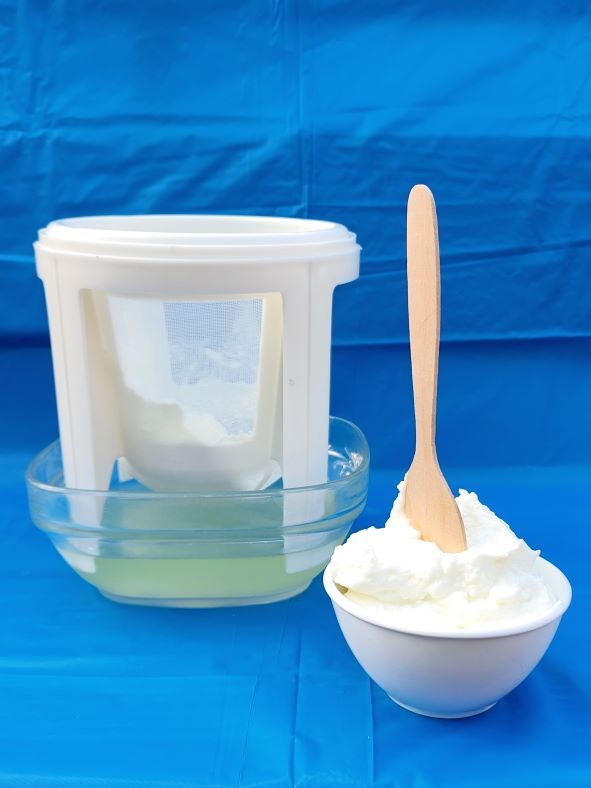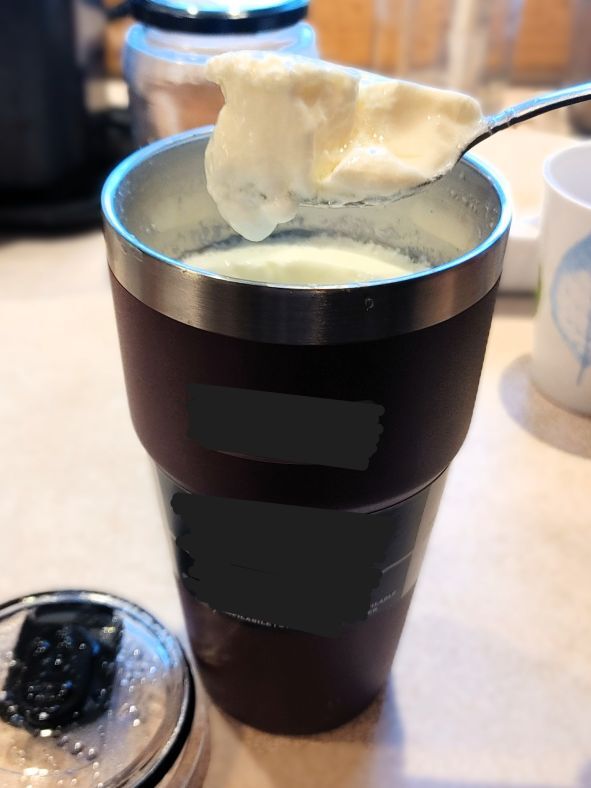Product Overview
Ingredients: Freeze-dried live active heirloom cultures (Lactobacillus bulgaricus and Streptococcus thermophilus). May contain traces of dairy.
Contains live probiotics. Heirloom. Traditional. Non-GMO.
Packaged in a facility that also handles products that may contain wheat, soy, eggs, milk, and fish.
The pouch contains 2 packets. Each packet makes 1 quart of yogurt, which can be recultured many times.
Make thick, probiotic-rich Greek yogurt in 4 easy steps! You’ll love it!
Make fresh yogurt again & again, by reculturing!
Since ancient times, people in the Mediterranean basin have been making traditional heirloom yogurt to nourish themselves and their families. This wholesome, probiotic-rich, velvety, living yogurt is known as Greek Yogurt.
Now you can make this exquisite staple yourself, in 4 easy steps. You don’t need an appliance. Strain the yogurt to make it high in protein, and save money by perpetuating your yogurt again and again.
Make healthy desserts free of added sugars, artificial flavors, or mystery ingredients: Top a few scoops of yogurt with fruits and nuts to make a real, unprocessed, fruit-flavored yogurt, brimming with live probiotics, that doesn't get any fresher than that! Better than any yogurt in the store.
Nurture your microbiome.
These statements have not been evaluated by the FDA. This product is not intended to diagnose, treat, cure or prevent any disease.
This product is formulated to ship without refrigeration. Refrigerate or freeze it on receipt until you're ready to use it.
Instructions for making Easy Greek Yogurt
To activate your starter, make the initial batch with a sachet of starter culture.
You'll need a yogurt maker, a sous-vide, or a similar appliance OR an insulated flask/Thermos, to maintain a warm temperature to incubate the yogurt. The yogurt needs to be sufficiently warm for several hours.
It's normal for the first batch to come out weaker. This is the activation batch. You can consume it and use it to make your next batch. Fermentation will get stronger in the next few cycles.
Remember to save ¼ cup of the resulting yogurt to use as a starter for your next batch. Repeat this many times to make yogurt again and again!
Makes: up to 1 quart/liter of yogurt
Preparation time: 10 minutes (+ 8 hours incubating in an appliance, and up to 24 hours, if needed, if not using an appliance)
You’ll need:
- A yogurt maker, sous-vide, or similar device OR a well-insulated flask/Thermos that holds up to 1 quart/liter, and an insulated box
- Up to 1 quart/liter dairy milk
- 1 sachet of Easy Greek Yogurt Starter (or ¼ cup of yogurt made with our Easy Greek Yogurt Starter)
- A thermometer
- Optional: Cheesecloth or ultra-fine mesh plastic/nylon strainer.
4 easy steps:
-
WARM: If using ultra-pasteurized milk, gently heat it to 110°F (43°C) − boiling is not necessary. If using milk that has not been ultra-pasteurized, slowly heat it to 212°F (100°C), stirring frequently to prevent scorching. Once heated, remove from heat and allow it to cool to 110°F (43°C) before proceeding.
-
MIX: Pour into the yogurt maker's container or insulated flask/Thermos and gently stir in 1 sachet of Easy Greek Yogurt Starter (or ¼ cup of yogurt made with Easy Greek Yogurt Starter) until completely dissolved. Do not whisk.
-
INCUBATE: If using a yogurt maker or similar appliance: Place the container in the yogurt maker, cover, and follow the appliance's instructions (or incubate at 110°F (43°C) for 8 hours). If the yogurt hasn't thickened, extend the incubation for 2-4 more hours, checking every 2 hours. Don't disturb the yogurt while incubating. If using a flask or Thermos: Close the lid, wrap with a blanket, towel, coat, sweater, or similar insulation on all sides, including top and bottom, and place in an insulated coolbox or styrofoam box. Incubate for 8-10 hours, and several more hours (up to 24) if the texture hasn't thickened. Don't disturb the yogurt while incubating.
- STORE: When the yogurt has thickened and has a pleasantly tangy flavor, it's ready. Secure the lid and refrigerate for at least 6 hours to set. The yogurt will continue to firm up as it chills. Keep the finished yogurt refrigerated.
- OPTIONAL: After refrigeration, strain the yogurt using a cheesecloth or ultra-fine mesh plastic/nylon strainer to make it even thicker and to increase the ratio of protein. When the liquid (known as whey) is removed from the yogurt via straining, the remaining protein becomes more concentrated.
- Make subsequent batches (many times over!): Once you've made your first yogurt, repeat the previous steps, but use ¼ cup of your finished yogurt as your starter culture (instead of a sachet). This is called ʻreculturingʼ, and you can repeat it many times to make homemade yogurt again and again. For optimal results, reculture within two weeks.
FAQs
- What kind of milk should I use? Any type of pasteurized or ultra-pasteurized dairy milk (skim, 1%, 2%, or whole). You can add a splash of Half & Half or cream, but don’t use all cream or Half & Half as it doesn’t have enough lactose for the bacteria to form yogurt. Goat milk may yield thin results. We haven’t tested shelf-stable, raw, or dairy-free options.
- Is the starter dairy-free/lactose-free? No, the starter may contain traces of dairy, is manufactured in a facility that also processes products containing dairy, and is designed to ferment dairy. That said, the presence of dairy in the starter is minuscule. The starter is comprised almost entirely of freeze-dried bacterial strains, with just a trace of dried organic skim milk powder as the medium on which the strains are proliferated. The tiny amount of milk powder that remains after proliferation is packaged with the strains and is metabolized when you make yogurt, during fermentation, so practically, almost none remains in the finished yogurt. That said, if you’re looking for a dairy-free option, you will need to decide whether this is suitable for you. Please note that we haven't tested our starter with dairy-free beverages.
- Is there a carrier in the starter? Not really. The starter is comprised almost entirely of freeze-dried strains, with just a trace of dried organic skim milk powder as the medium on which the strains are proliferated. The tiny amount of milk powder that remains after proliferation is packaged with the strains, with no additional carrier.
- What’s the difference between the Greek and Skyr yogurt starters? Both Greek and Skyr are heirloom (self-perpetuating and traditional), and yield thick, mild, and creamy yogurts, with some variation in texture and flavor. They originate in different parts of Europe and contain slightly different types of species, and slightly different proportions of each species. Please do not ferment them together; they are two distinct products. The composition of combined batches has not been tested.
- How can I make my yogurt thicker/high-protein? After refrigeration, strain the yogurt using a cheesecloth, towel, or an ultra-fine mesh plastic strainer. When the liquid (known as whey) is removed via straining, the remaining protein becomes more concentrated. Higher fat milk will naturally yield thicker results. Goat and low fat milk will yield thin results. Use whole milk. You can add a splash of cream or Half & Half (known outside the USA as 'coffee cream' or similar, and made of part cream part milk). Donʼt use only cream or Half & Half, as they may not have enough lactose to form yogurt. Even if not fully firm, the yogurt will firm up in the refrigerator overnight.
- My yogurt is still liquid after incubation. Your jar may have been too cold. You could try placing it in a container filled with warm water (not hot), or next to a warmed-up neck-heating pad (like the ones used for pain relief). Change the water (or re-heat the pad) once it cools, as necessary. Check the yogurt after a couple of hours, without disturbing it. If this is the activation batch (when you use starter from a sachet), your yogurt may not be fully set. It will firm up in the refrigerator. It's normal for the first batch to come out weaker. Fermentation will get stronger in the next few cycles. Low-fat and goat milk yield thin results. When incubating without an appliance, use a good-quality, well-insulated, sturdy stainless steel flask/Thermos (or a glass jar), and make sure it's well-wrapped on all sides, including top and bottom, and placed in an insulated box. The aim is to keep the yogurt warm enough for incubation to occur. Always follow the instructions closely, including recommended ingredients.
- There's some translucent liquid in my jar. This is either natural condensation, or whey that occurs naturally in dairy fermentation. It will subside in the refrigerator.
- Can I make yogurt if I don't have a device or insulated flask? Yes. Use a quart glass jar and follow the Thermos instructions. Make sure to keep the jar warm during incubation. For that, you could use a container filled with warm water (not hot) or a warmed-up neck-heating pad like the ones used for pain relief, and change the water (or re-heat the pad) once it cools, as necessary. Keep the jar as insulated as possible.
- Why do we heat pasteurized milk? To eliminate any competing bacteria, and to denature the protein so that it forms a thicker curd. Ultra-pasteurized milk should only be warmed up to 110°F (fermentation temperature).
- How to prevent the milk from scorching? Keep stirring even when using a non-stick pot. Another effective method is the double-boiler, which provides indirect heat. To use this method, place your milk in a smaller pot, and place that pot inside a larger pot filled with water. This way, you won't be heating the milk directly. Make sure the water level does not exceed the bottom of the smaller pot. Keep stirring the milk as it heats up.
- How to ensure the starter powder dissolves in the jar? Mix it well with a spoon. One trick is to mix the powder in a smaller jar with a smaller quantity of milk, and then add the mixture back into the main jar, stirring well to combine.
- I let the milk cool too much. What should I do? Gently heat the milk back to 110°F (43°C) and then add the starter and proceed with the rest of the process.
- Can I whisk the starter into the milk? Whisking introduces bubbles that may slow down fermentation. Use a spoon to mix in the starter until completely dissolved.
- What if the temperature drops while incubating? The yogurt needs to be sufficiently warm for several hours for incubation to occur. While 110°F is ideal, fermentation will occur at a range of about 104 -110°F. One trick is to pour the milk into the Thermos when the milk is just over 110°F. The contact with the Thermos will drop the temperature a little. It's normal for the temperature to slowly decrease if not using a device. Keep the Thermos well-wrapped and insulated, and do not disturb the contents while incubating. If you don't have an insulated box, you can place your Thermos inside a well-insulated appliance such as the microwave or oven without switching it on, just to provide insulation.
- Should I secure the lid while incubating? It doesn't really matter whether the lid is secure or loose, or if you just use the device's cover, or even just a towel or similar. The idea is to minimize heat loss and prevent unwarranted contaminants from entering the jar. While the bacteria in this starter do need some air, the gap between the liquid and the lid, even if secure, should be sufficient.
- I want to make larger quantities. Increase quantities only after you have continuous good results. This may take a couple of cycles until the bacteria fully kick into gear. Use your ready yogurt as your starter, without adding starter from the sachet. Keep the ratios in proportion: To make 2 quarts/liters, use 2 quarts/liters of milk and ½ cup of your ready yogurt as your starter.
- Why is the yogurt stringy? The bacteria in this yogurt naturally have this effect.
- How often should I reculture? Ideally, within two weeks or so.
- How many times can I reculture? For as long as your batch thickens and comes out like yogurt.
- How long does an unopened sachet of starter keep in the refrigerator? The Best By date is printed on each pouch and sachet. Keep in the refrigerator or freezer until you're ready to use it.
- Can I freeze the yogurt? Yes, freezing does not kill the bacteria. You can make ice cream with it, but expect the texture to be grainier. We haven't tested yogurt recultured from a previously-frozen yogurt.
- How should I store the yogurt while I'm away? If you plan on consuming/reculturing the yogurt within a couple of weeks, keep it in the fridge. Flavor and texture may change over time. When you get back, check if it's still good. If you use it to make a new batch, you may need to extend culturing time and/or use more of your existing yogurt (as a starter) to let the bacteria catch up by proliferation. It may take a few cycles to return to full vigor. If the new batch turns out fine, keep using it. If not, discard, and use a new starter from a sachet to start over. We haven't tested yogurt recultured from a previously-frozen yogurt.
- Do you ship to Hawaii / Alaska / Puerto Rico? Yes. Shipping fees to Hawaii, Alaska, and Puerto Rico are the same as to any address within the contiguous USA. We use ambient shipping (non-refrigerated and without ice). Our starters are designed to remain active for several weeks in transit in hot weather, without refrigeration or ice. The formula and the packaging provide excellent protection for the live strains. See "I live in a hot place. Is the starter still active if it's shipped unrefrigerated in hot weather?"
- I live in a hot place. Is the starter still active if it's shipped unrefrigerated in hot weather? Yes. Our starters are not affected by heat in unrefrigerated transit. They are designed to remain active for several weeks in hot weather, including heatwaves, without refrigeration or ice. The formula and packaging provide excellent protection for the live strains, which are freeze-dried and not heat-sensitive in the sealed packet. We have thoroughly tested this. For this reason, we use ambient shipping, which is significantly less costly for the customer. We keep the starters in a cold warehouse until orders are shipped, and when your order is shipped we send you a tracking number so that you can see when it is due to arrive. Once received, the starter should be refrigerated or frozen for the longterm, and you can use it as normal. It's normal for the first batch to come out weaker. The bacteria take a cycle or two to fully kick into gear. This has nothing to do with the unrefrigerated shipping.
- I forgot to refrigerate the starter. Is it still active? This depends on how long the starter has been left at ambient temperature. The starter is designed to remain active for several weeks in hot weather, including heatwaves, without refrigeration or ice, for transit purposes. The formula and packaging provide excellent protection for the live strains. If the delay is much longer and the temperatures are very high, the viability may be affected. If your batch thickens and tastes like yogurt, you're good. It's normal for the first batch to come out weaker. This is the activation batch. Fermentation will get stronger in the next few cycles.
- What are the starter's caloric/nutrition facts? These are printed on the back of the pouch. The final yogurt's nutritional values depend on the dairy you use. For example, whole milk will have more fat than skim milk.
- Is the starter certified Kosher? No. Our starters are not certified Kosher.
- Where is the starter made? In the EU.














